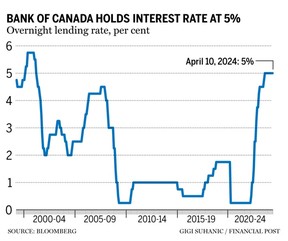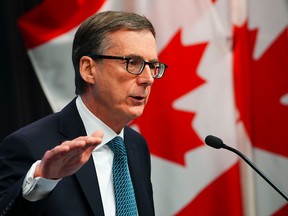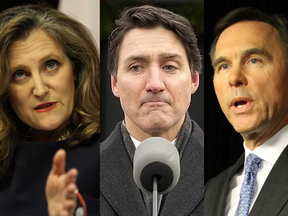Central bank holds rate at 5% but sees progress on inflation
Article content
The Bank of Canada left the key overnight interest rate at five per cent Wednesday, but governor Tiff Macklem said a June cut was “within the realm of possibilities.”
At a news conference after the decision, Macklem said central bankers are confident in the inflation progress they’re seeing and have seen since January, including inflation expectations and corporate pricing activities — but they need to see it for longer to make sure it is sustained rather than a blip.
Advertisement 2
Article content
Article content
“The further decline we’ve seen in inflation is very recent. We need to be assured it’s not just a temporary dip,” Macklem said.
While the consumer price index and core inflation have eased in recent months, inflation is “still too high and risks remain,” the central bank said in an April 10 statement, adding that its governing council will wait for “evidence that this downward momentum is sustained” before moving rates lower.
“Governing Council is particularly watching the evolution of core inflation, and continues to focus on the balance between demand and supply in the economy, inflation expectations, wage growth, and corporate pricing behaviour.”
CPI inflation slowed to 2.8 per cent in February, with easing in price pressures becoming more broad-based across goods and services.
“However, shelter price inflation is still very elevated, driven by growth in rent and mortgage interest costs,” the central bank said in a statement.
Core measures of inflation, meanwhile, which had been running around 3.5 per cent, slowed to just over three per cent in February, and 3-month annualized rates are suggesting downward momentum. The central bank expects CPI inflation to be close to three per cent during the first half of this year, move below 2.5 per cent in the second half, and reach the two per cent inflation target in 2025.
Article content
Advertisement 3
Article content
Andrew DiCapua, senior economist at the Canadian Chamber of Commerce, said energy price volatility remains a wildcard for the central bank, despite a more optimistic GDP forecast and anticipation of reduced inflation by year’s end, with global oil prices coming in ahead of the Bank of Canada’s assumption in January.
“At their June meeting, they’ll have over three months of inflation data, aided by survey results trending in the right direction,” DiCapua said.

When the central bank decision-makers met to discuss last month’s policy rate decision, they did not all agree on what economic signals they would need to see to start cutting rates, a summary of those deliberations revealed. However, they did agree that the first cut would likely be in 2024.
The “diversity of views” concerned both when there would likely be enough evidence to cuts rates, and how to weight the risks to the central bank’s economic outlook.
At the news conference Wednesday, Macklem and senior deputy governor Carolyn Rogers said there was continued debate at this month’s rate-setting meeting about the timing of a cut, a product of governing council members who come to the table with different experiences and backgrounds. They declined to elaborate on where they differ most and whether it’s on specific economic data points or risks to the economic forecast such as a larger-than-expected increase in housing prices.
Advertisement 4
Article content
“Our background, our perspective leads us to sort of weight the data a bit differently, sometimes interpret it a bit differently,” Rogers said. “But that’s a good thing… It forces us to have a really robust conversation and I think get to the best possible decisions.”
Economists, too, have diverged in their projections of when economic indicators will justify a cut, with some expecting the first rate cut to come as early as June and others predicting September as the best-case scenario. Some prognosticators recently pushed their forecasts out further as the economy appeared in better shape than expected and the risk of inflation remained.
The Bank of Canada forecasts gross domestic product growth of 1.5 per cent in 2024, 2.2 per cent in 2025, and 1.9 per cent in 2026 and said the strengthening economy will absorb excess supply in 2025 and 2026. The central bank revised its forecast for global GDP growth upwards to 2.75 per cent in 2024 and about three per cent in 2025 and 2026.
“Inflation continues to slow across most advanced economies, although progress will likely be bumpy,” the Bank of Canada statement said, adding that inflation rates are nevertheless projected to reach central bank targets in 2025.
Recommended from Editorial
-

Bank of Canada holds interest rates: Read the official statement
-

Canada to dodge recession, but economy remains fragile
-

Bank of Canada survey finds fewer businesses expect a recession
At a previous rate-setting announcement earlier this year, Macklem said that when interest rates do start to come down, he doesn’t expect the pace to match the steep trajectory of increases that began in the spring of 2022.
Bookmark our website and support our journalism: Don’t miss the business news you need to know — add financialpost.com to your bookmarks and sign up for our newsletters here.
Article content
Bank of Canada holds interest rate at 5 per cent
2024-04-10 13:45:42








